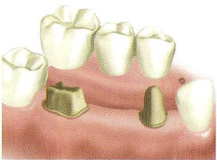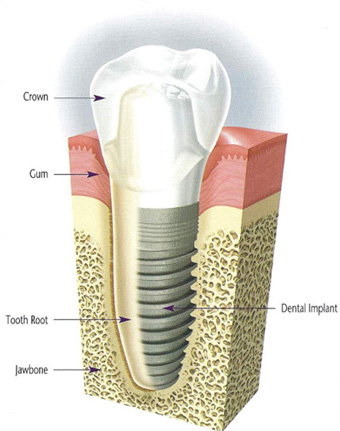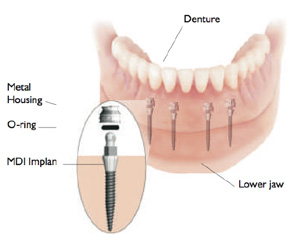Everyone deserves a beautiful smile. With the tremendous advances in esthetic dentistry, there’s no reason to put up with anything less. With Nobel Biocare implants and Procera® Crowns, a missing tooth can now be easily, comfortably, and beautifully replaced.
Historically, a bridge was used to replace a single missing tooth. Bridges are constructed of metal sub-frames with tooth-colored porcelain applied to approximate the natural color of your existing teeth.
Bridges use the teeth on either side of your missing tooth to provide support for the artificial tooth that fills in the space where your natural tooth is missing.
The goal of the bridge is to restore chewing function and achieve an acceptable esthetic outcome. Unfortunately, bone under the replacement tooth is no longer stimulated by chewing and is often resorbed into the body, creating a slowly growing gap between the replacement tooth and the gums.

Dental implants often provide a more advanced replacement technology for a missing tooth than a traditional bridge. Dental implants eliminate the need for grinding down healthy teeth.
Dental implants are small metal screws designed specifically to replace your natural tooth root. Manufactured from titanium, dental implants provide a highly biocompatible surface, encouraging bone to attach to the implant during the healing process to ensure long-term results.
Dental implants create stimulation to the underlying bone, enhancing long-term esthetics.
Restoring your tooth with all-ceramic components(crown and abutment) can result in a beautiful, natural-looking, translucent tooth, just like the rest of your teeth.

Dental implants are titanium tooth “roots” that are used to replace missing natural roots. Once in place, they become firmly attached to the bone. After they are solidly affixed to the bone (this process is called “Osseointegration”), an artificial tooth is attached to the implant.
Anyone with missing teeth. Dental implants can be used to replace single or multiple missing teeth. They are also of great help for people who wear dentures.
Dental scientists have been experimenting with methods of restoring missing teeth with “permanent artificial replacements” throughout history. Dental implants can be traced as far back as the ancient Egyptians. Modern dental implants and the appropriate techniques for their use were refined during the 1950’s and 60’s. An extensive period of clinical tests and improvements in implant design and delivery techniques started their general popularity in the 1980’s. During the past quarter century, designs continued to improve and an ever-increasing number of dentists began to train and learn their delivery techniques. As of today, the art and science of placing dental implants has become extremely popular. It is a routine restorative procedure in many dental offices and is in use all over the world.
Yes. Dental implants come in a variety of sizes and shapes and can have a surface of titanium or titanium that is coated with a substance that encourages the bone to attach it to the implant. The two main categories of dental implants are the full-sized implants and miniature dental implants. The variety of sizes, shapes and configurations is necessary because of the wide range of anatomical differences that patients present. Such factors as amount of bone, bone quality, the shape and relationship of the upper and lower jaws and the amount of implants required to restore a mouth are some of the reasons for the different selection of implant systems.
Many implant designs exist. Each dental implant patient presents a unique set of clinical factors. These differences (e.g. bone configuration, bone quality, area where implant is to be placed, type of dental procedure that is to be done, etc.) often demand specially sized and configured implants, thus the need for a wide variety of sizes, shapes and implant design features. In some cases, dental implants are designed to be placed into the socket immediately after a tooth has been extracted. Your dentist will first create a treatment plan for your case. He will then choose the most favorable implant configuration that will best suit your particular needs.

Mini dental implants are ultra small diameter (1.8 millimeter width), biocompatible titanium alloy implant screws, conceived and developed over 50 years ago by Chercheve in Europe. Then, Dr. Sendax created a unique design of this innovative dental product as a transitional device to help support fixed bridge replacements for missing teeth. His novel theory was that mini implants could function free standing by themselves or in combination with natural tooth supports and/or larger conventional type implants. This was a revolutionary concept in dental science.
Late in 1997, Dr. Sendax collaborated about his mini-implant theory and design concepts with a colleague, Dr. Ronald A. Bulard. Convinced they were on to something special, and recognizing the need for dental applications involving the new implants. Drs. Sendax and Bulard spent countless hours studying and refining the original creative design, resulting in a more efficient top and collar for the implants. The two doctors recognized the need for dental applications involving the new implants. Since then, different companies worked on the design and tried to improve the design which created the most advanced mini implant on the market today – the new MDL mini implant with the osseon surface.


Yes. After research, clinical trials and exhaustive studies, a formal application was filed with the FDA in Washington, D.C. seeking permission to market the mini-dental implant devices to the general public. After providing satisfactory technical and clinical evidence to that federal agency that the product was safe for public use and in fact had beneficial attributes, the FDA granted its formal consent to market the mini-implant device not only as a transitional or temporary dental product, but significantly, as a long-term device. No other mini dental implant product currently on the market can make this claim.
When critically needed for support purposes, and where solid bony adaptation (integration) has clearly occurred, mini implants can function as long-term supporting structures rather than as short-term or medium term devices. In fact, some have been successfully functioning in patients’ jaws for several decades. Further, they’re particularly effective in crown and bridge applications, as well as single-tooth replacements.

When critically needed for support purposes, and where solid bony adaptation (integration) has clearly occurred, mini implants can function as long-term supporting structures rather than as short-term or medium term devices. In fact, some have been successfully functioning in patients’ jaws for several decades. Further, they’re particularly effective in crown and bridge applications, as well as single-tooth replacements.
Miniature Dental Implants are placed easily and simply into the jawbone. Their small size affords a number of advantages: Minimum trauma to the implant site, no need for surgical preparation, and immediate stability upon completion of placement. The top of the mini implant consists of a “ball” head which projects above the gum. Anywhere from two or more implants are placed, depending upon the dentist’s analysis of the case. Once placed, either a new denture has been already fabricated or the patient’s old denture may be used. Female retention caps are inserted into the inside of the denture and positioned to snap over the “ball” head of the implant. This greatly enhances retention, reduces denture movement and facilitates eating and speaking. Thousands of grateful patients are all over the world have been blessed with this effective, easily placed, economical dental system.
Miniature Dental Implants, or Mini-implants have become increasingly popular during the past decade. As of today, they are used extensively throughout the world. Miniature dental implants have a number of advantages when used properly. Their small size allows them to be placed inbetween full sized implants during a full-mouth rehabilitation case. An esthetic, functional provisional bridge can then be made. In addition, miniature dental implants are used to replace missing front teeth where the space between the missing tooth and the adjacent teeth will not permit the placement of a full-sized dental implant. Lastly, the miniature dental implant gains its retention in a different manner than standard sized implants. The small, screw-shaped miniature dental implant wedges itself and expands the bone as it is inserted. Upon the completion of insertion, the elastic properties of bone create an intimate contact between bone and fixture, thus rendering it extremely solid and stable upon placement. This allows it to be used to immediately replace a missing tooth or to stabilize loose dentures. The patient can walk out of the office comfortable and functional after just one visit.
The term over denture is used to describe a denture that is secured and stabilized by dental implants. This type of denture typically requires two to four dental implants. The denture is removable by the patient.
Definitely. Implants have been of terrific help for patients who wear dentures. Dentures in reality are a poor substitute for natural teeth. People do not have the tactile sense when chewing that is transmitted through the roots of teeth; dentures are often ill fitting (especially lower dentures) and have but a fraction of the chewing and cutting efficiency of natural teeth. Ask any person who wears a lower denture and you will often find the myriad of problems they experience (despite how skillfully they have been made), dental implants have created a revolution for denture wearers and are of immense help. If a denture wearer is not a clinical candidate or cannot afford to have his/her denture replaced by a full-mouth dental implant reconstruction which results in a “permanent” bridge being placed (finances and bone configuration are the two biggest obstacles to this treatment), “over denture” dental implants can be the answer.
Not at all. Healing times vary, but if your dentist feels your individual case warrants a more extensive healing period he may prescribe a temporary restoration. A temporary tooth or bridge allows the patient to have esthetics and function immediately. The patient can walk out of the dental office and enjoy socializing and a pleasant meal that very same night. Another solution is to have a patient who is wearing dentures continue to wear their dentures until the implants are fully functional.
Usually no surgery is needed to place mini-implants. They are put into immediate biting or “loading” function thanks to their “self-tapping” design, thereby anchoring a fixed bridge system. As a result, it is often possible to provide the complete mini implant service in a single office visit.
It must be recognized that all implants systems as well as natural teeth are subject to potential failure due to natural causes, including osteoporosis, poor oral hygiene, wear and tear attrition, poor health, heavy, stressful biting habits, and lack of follow-up dental maintenance care. Mini implants similarly do not carry any actual or implied guarantee of longevity. However, the loss of a mini implant is a far less critical event to the patient since it may be replaced at relatively minimal cost compared to the larger conventional implants, and with minimal associated bone or gum deterioration. Case failures involving mini implants are extremely rare.
As with all dental applications, there’s a short adjustment period during which time the patient becomes comfortable placing and removing the denture. Typically, this involves removal of the lower denture in the morning, brushing the gums and implant area with a toothbrush and mouth rinse, rinsing the denture itself, then replacing it. The result is a normal day’s activity for the patient, including eating, talking, taking a nap, etc. Then, in the evening, the denture is usually removed again and the mouth thoroughly rinsed. The patient then opts to sleep with, or without his or her denture. The result is a fully functioning dental appliance that works, is socially acceptable, has a comfortable fit, etc.
Mini-dental implants are surprisingly affordable and are usually available at a fraction of the cost of traditional implants. By choosing mini-implants, you’ve chosen an enhanced way of life free of a lot of the discomforts and heartaches of a loose or ill-fitting denture. That’s worth a lot.